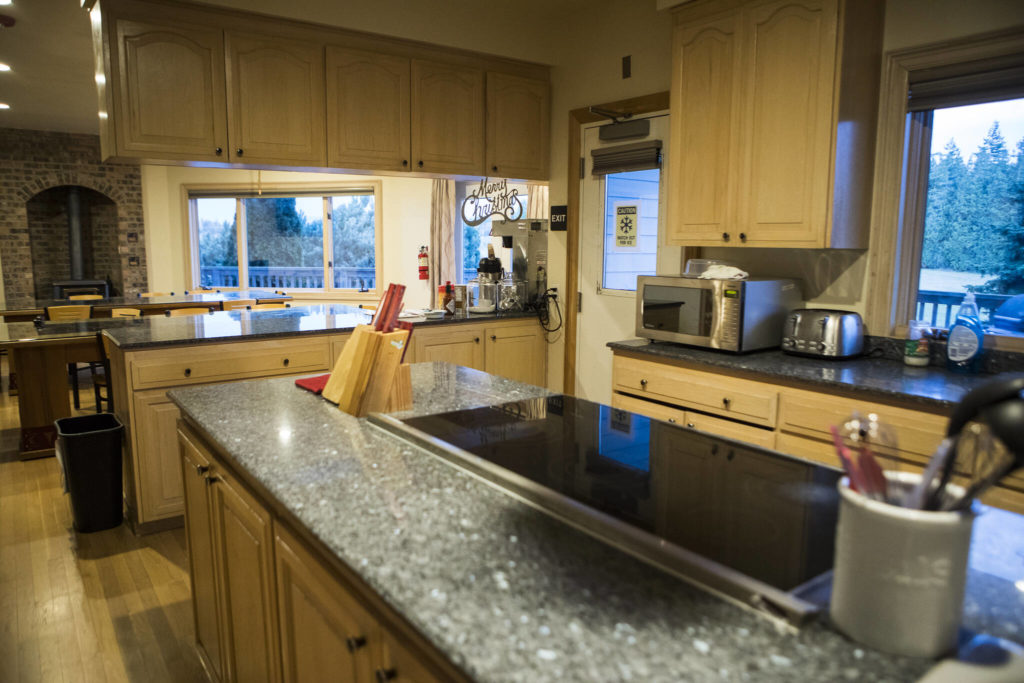TULALIP — After living with addiction for over three decades, Ambrose James has 30 months of sobriety under his belt.
James said he made a commitment to recovery at the Tulalip Tribes’ Stanwood Healing Lodge, where he met some of his closest friends, talked through his trauma with counselors and made a “beautiful” collage documenting his healing journey.
“I’m always going to be an alcoholic, an addict, but I’m going to be clean and sober day by day,” he said. “If it wasn’t for my counselor sending me to treatment and telling me about the Healing Lodge, I wouldn’t be here right now.”
This year, the Tulalip Tribes received a three-year grant of over $1.3 million from the U.S. Department of Justice to expand existing substance abuse treatment and wellness programs. Like other social services the tribes offer, the lodge is funded through grants and the tribes’ gaming revenue, said Misty Napeahi, tribal council member.
At the Healing Lodge, the federal money means a new outpatient counseling center and more housing for those in recovery, said Diane Henry, executive director of clinical support. The tribes plan to buy two modular homes and convert existing outbuildings into group therapy rooms. The goal is to eventually bring Tulalip Family Services on site.
“It will help us to … keep intact the premise: to maintain long-term clean and sober folks,” Henry said.
The Tulalip Tribes opened the Healing Lodge in 2015. It provides a space for those coming out of inpatient treatment to readjust to society, Henry said. In 2020, the lodge served 37 people in recovery.
“It seemed like that was a gap in services — where the re-entry back into the community after getting treatment was something we were lacking,” Napeahi said.
At the lodge, residents learn “how to cook a nutritional meal, how to prioritize their bills, or their court hearings, or any of the mess that they got themselves into while they were active in their addiction,” Napeahi said. “… It’s really their opportunity to start to unravel some of that, and have the support around them that it’s not so overwhelming that they would relapse.”
Lodge staff help residents open bank accounts, get their driver licenses, buy cars and find a place to live. Residents get access to GED and high school completion courses, job training, and parenting courses.
They also receive transportation to sober support groups like Alcoholics Anonymous, Narcotics Anonymous, Cocaine Anonymous — as well as mental wellness groups and counseling.
The lodge is open to all Native Americans enrolled in a federally recognized tribe, manager Steven Iron Wing II said.
Cultural activities are central to the healing, Henry said.
“People are needing to know who they are and where they come from,” she said. “Some folks lost their way as a result of intergenerational trauma.”
Many families are trying to heal wounds from the cultural genocide committed in U.S. Indian Boarding Schools. From the late 1800s to the mid 1900s, thousands of Native youth were forcibly taken from their homes and placed in the schools. They were beaten for speaking their Native languages. They worked industrial jobs as elementary students, and for most of the year they didn’t see their parents. Many of them never came home.
Iron Wing II is enrolled Sicangu Oyate Lakota. His father is a U.S. Indian Boarding School survivor.
His own addiction history led him to become a chemical dependency professional.
“I wanted to do something to give back to the Native community at large,” Iron Wing II said.
“There’s a history of unaddressed abuse within families — you can go back to the boarding schools,” he said. “It creates a detachment and a lack of empathy for even your own family members.”
And that emotional detachment leads some to pick up drugs, Iron Wing II said.
“You have families that, 50 years ago, a person was removed from their family for no right reason,” Napeahi said. “And then they go out in the world … they struggle with addiction, and then they have their own children and their own children wind up in the system. And it just perpetuates itself over and over and over again.”
Boarding school survivors have reported higher rates of drug and alcohol use disorders, and are more likely to experience suicidal thoughts, according to a 2012 study.
About 37% of Native Americans who had at least one parent that attended an Indian residential school considered taking their own lives, compared to about 26% for those whose parents did not, according to a First Nations Regional Longitudinal Health Survey.
Reconnecting people with the culture and community can help stop the cycle.
Lodge residents can make and beat drums, design ribbon skirts and heal in sweat lodges on the 30-acre property. The lodge offers space for residents to build community, and find a new sense of belonging and purpose after coming out of the depths of their addiction.
“It’s a good place. It’s a safe place,” James said. “I’ve got a job and a place. If I wasn’t clean and sober, I wouldn’t have all these things. … I’m safe now.”
Isabella Breda: 425-339-3192; isabella.breda@heraldnet.com. Twitter: @BredaIsabella.
Talk to us
> Give us your news tips.
> Send us a letter to the editor.
> More Herald contact information.































